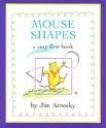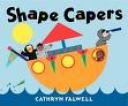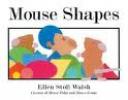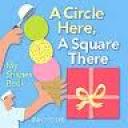Introduction:
Under the Geometry section of the SOL’s for kindergarten there is a focus on plan figures. Within this category students k.11) should be able to identify, describe, and trace plan geometric figures (circle, triangle, square and circle). Being able to identify these shapes is an important aspect when students begin to learn more advanced geometric terms. Students need to be able to identify theses shapes when they begin to learn about area and perimeter. In addition, having the knowledge of the shapes characteristics will help students in their everyday lives. Shapes is an important aspect that begins at an early age.
These literature connections will help children improve their shapes knowledge:
Mouse Shapes: a very first bookby Jim Arnosky is a great reference tool for students to have. The book demonstrates what all of the shapes that kindergartens must know look like. In addition, there are various other shapes that students can begin to look at. Even though these shapes are not part of the core four, it provides an opportunity for students to expand their knowledge. In addition, this book could be used as an extension for those students who are surpassing grade level expectations.
There’s a Square: A Book About Shapes by Mary Serfozo, illustrated by David A. Carter takes children are an adventure of what the different shapes look like. First they are introduced to a description of the shape then they several forms of a the shape; they see what the shapes looks like in different sizes. Finally the readers are asked to find the shape in a picture. This would be a great way to introduce shapes to students or could even be used as a review. With the picture look, student are given an opportunity to practice their skills. At the end, students are given time to review what the shapes look like. They are shown again what the shapes look like with the shapes name underneath the shape. This is a book that could be read to the class and be available to students if they would like to learn about other shapes other than a circle, square, triangle, and rectangle.
Shape Capersby Cathryn Falwell is kind of laid like a game. Each shapes begins with a “shake, shake, shake” then the shape is introduced. Following the introduction of the shape there is a brief description of what the shape looks like, with various examples of the shapes in different colors and sizes. After all shapes have been described the reader is introduced to the shapes again with various forms of the shapes appearing near the name. After that, the readers are taken on a tour of various things that can be made by the shapes such as a car, spaceship, dinosaur, and ship. This allows the reader to see that shapes are in our everyday lives. At the end of the book, students can look at the pictures they provide and see if they can identify the triangles, squares, circles, and rectangles. This is a great book to introduce the concept of shapes and can also be used as a review with the ending of the book. In addition, it allows those students who are excelling at the concept to explore other shapes, furthering along their knowledge. The last page provides a brief explanation of an activity that can be completed using shapes.
Mouse Shapes by Ellen Stohl Walsh takes students on a journey through the world of shapes.There are mice that are being chased by a big cat. When running from the cat, the mice come into contact with a cluster of different looking shapes. They are now learning what these shapes look like. In order to fool the cat, the mice begin to make objects with the various shapes.
Students see how the shapes can be used in real life while also seeing what the shapes look like.
A Circle Here, A Square there: My Shapes Books by David Diehl is a beginning book for students to use. Students see what the shapes name look likes in big letters then they see what the shapes look like in various forms. These various forms based upon what children would see in their real lives, such as a present for a square and a scoop of ice cream for a circle. This book would best used as a reference for students if they need a reminder on what the shapes look like. Also, it provides a spelling opportunity for students by having the name of the shapes in big print.
Web Annotations for Students:
In I Spy Shapes students are shown various pictures and asked to find all the triangles, etc in that picture. There is a number counter at the top of the page to help students keep track of how many of the shape they have found. Students are allowed to keep going until they have found all the shapes.
Fun with Shapes is a webquest that studnets can complete after learning about shapes. In this webquest students are first review what each of the shapes look like. With this story, there is a desciption of what the shape looks like with a picture following. In addition, the story allows the students to review the colors. After reading the story, they have various activities that they are to complete relating to the shapes they read about in the story. With this webquest, the teacher can read the story aloud with the student then pair students up to complete the webquest.
Story of Shapes is an online story of shapes that students can either read or listen to. The storyteller describes the shape and sometimes provides an example of what it may look like. This a visual and oral story for the students. They are seeing the description as it is being said. It provides an opportunity for students to see other ways that the shape can be formed and other descriptions that might make it easier for them to remember the shapes.
Buzzing with Shapes is a two player game that has studnents pick the shape that matches the description that is given to them. If they chose the wrong shape they are given an explanation of why that shape is wrong ( a desciption of what their shape looks like). This could be used as a review game and can even be used as an expanding on the knowladge allowing studnents to explore other shapes besides the circle, square, triangle, and rectangle.
Identify Shapes I students are given a description or picture and asked to choose the correct answer.
Additional Resources for Teachers:
ABC Teach provides various coloring pages for the different shapes that will be taught to our studnets. Other shapes are included but these can be used as an extra thing for students when they are all done with their work.
DLTK’s Growing Together provides different activities that teachers can used during shapes lesson. to help enhance students knowladge. There are different games, a poem and various worksheets to help children understand the topic.
Hummingbird Educational Resources is a great tool to find different lesson plans and activities that can be used in the classroom. In addition, there songs that can be recorded that teachers play to their students or place at listening stations. All of the activities are grade appropriate and it is a great tool to use if having trouble coming with a cute way to introduce or teach the concept of shapes.
Shapes is a great site for various worksheets, ranging from extra practice to assessments. These sheets are great tools to have available in the classroom if students are done with an assigment and would a little extra practice. In addition, there are tracing pages that can be used to help students grasp one part of the SOL which is being able to trace the shapes.





